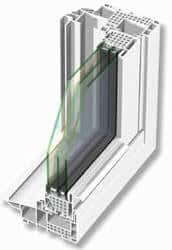Granbury Door and Window is often hired to replace Insulated Glass, or IG – due to breakage or when windows fog because of seal failure. The term Insulated Glass is a little confusing, as the glass is not actually insulated, but the glass itself surrounds the insulating material. The real term is an Insulated Glass Unit, but we say IG for short.

Here’s a diagram from American Window Systems who is one of our favorite manufacturers. It shows a triple-pane IG on our AWS R-6 Energycore Vinyl Window, but most insulated glass is only double paned.
In it, you can see there are panes of glass, separated by spacers that are scientifically bonded to the glass which holds the IG unit together. The spacers also seal the space between the glass – either maintaining a vacuum, or keeping in a dry gas. This dead air space is insulated by reducing the transference of hot or cold before it reaches the inner pane.
IGs are pretty standard in windows, due to their energy-efficiency. However, you can supercharge your energy savings by getting Low-E windows. Low-E indicates a very thin “film” that is integral to the window that helps to reflect heat in or out of the building, depending on where it is applied. This coating is added during the manufacture of the glass, when it is still hot.
IGs have a minimal effect on the window’s appearance. The spacers generally hidden behind the window stops or beading around the window. If you get up close, you can look into the edge of the IG and see the spacers. They are virtually invisible from a distance. From the street, you wouldn’t notice a difference.
Why have an IG?
- In cold climates, the inside surface of a window with an IG will be warmer than a single pane glass window. If the surface of the glass is colder, then drafts of air will make the room colder. My first house (with cheap windows) I’d see the curtains actually swaying in the draft created by air cooled by a single-pane glass during a cold night.
- Another downside is that the cold surface can generate condensation. Condensation is created when moist air is cooled quickly, since cold air holds less moisture than warm air. Condensation ruins the view out of the window, and if it runs down the window, can cause damage to the window, paint, or fabrics.
- Low-E coatings are applied to one of the surfaces on the inside of the IG, which protects the coating from damage. This also lets you clean the outside of the IG (whether outside the building, or inside) normally. So you can’t get Low-E coatings without an IG.
- Since an IG makes a more energy-efficient window, it saves you money every month on your energy bills. Nowadays, homes with IG and otherwise energy-efficient window are expected, and your home value will suffer if the buyer finds out you don’t have them.
For all the above reasons, if you’re buying a window, we highly recommend having IG units, not flat glass. When you are replacing a full window, the cost of IG does not add much to the cost, but brings many benefits.
Our residential sales team would be glad to provide a free estimate for replacing non-IG or non-Low-E window units. Give us a call!




